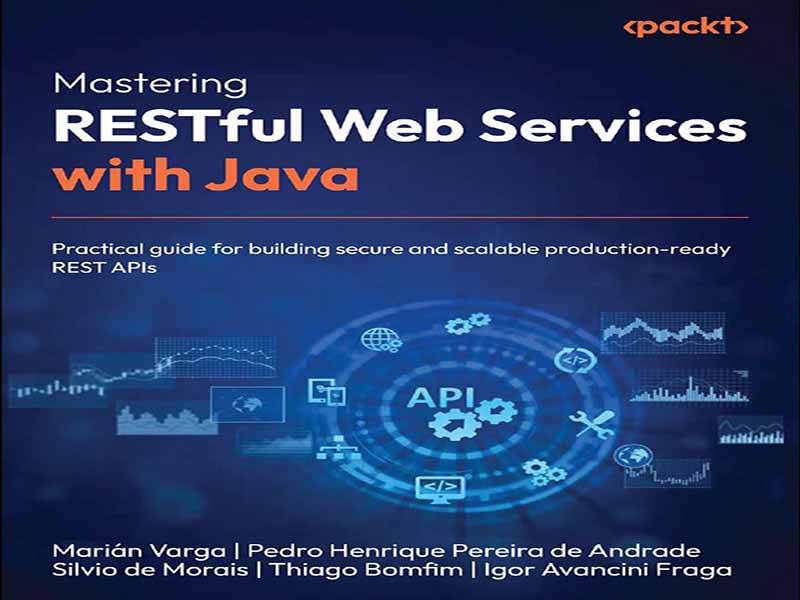- عنوان کتاب: Mastering RESTful Web Services with Java -Practical guide for building secure and scalable production-ready REST APIs
- نویسنده: Marián Varga
- حوزه: توسعه API
- سال انتشار: 2025
- تعداد صفحه: 433
- زبان اصلی: انگلیسی
- نوع فایل: pdf
- حجم فایل: 4.30 مگابایت
این کتاب یک راهنمای عملی برای طراحی، ساخت، مستندسازی، آزمایش و استقرار APIهای RESTful با استفاده از چارچوبهای مدرن جاوا است. APIهای REST به روشی استاندارد برای برقراری ارتباط بین سیستمها، به ویژه در میکروسرویسها و سایر معماریهای توزیعشده، تبدیل شدهاند. با توجه به اینکه جاوا یکی از پرکاربردترین زبانها برای توسعه backend است، درک نحوه ساخت APIهای مؤثر با جاوا یک مهارت کلیدی برای توسعهدهندگان امروزی است. در طول فصلها، تکنیکهای عملی با استفاده از Spring Boot، OpenAPI و سایر ابزارها و کتابخانههای محبوب را بررسی خواهید کرد. همچنین با کانتینرسازی، مشاهدهپذیری، امنیت API و تنظیم عملکرد – هر آنچه برای ایجاد APIهای قوی، مقیاسپذیر و قابل نگهداری نیاز دارید – آشنا خواهید شد. چه در یک استارتاپ کار کنید و چه در یک شرکت، مهارتهای ارائه شده در اینجا به شما کمک میکند تا خدمات backend با کیفیتی را ارائه دهید که مطابق با استانداردهای توسعه مدرن باشد. این کتاب برای توسعهدهندگان backend جاوا با چند سال تجربه که به دنبال بهبود طراحی، عملکرد و مقیاسپذیری APIهای REST خود هستند، ایدهآل است. همچنین منبعی ارزشمند برای رهبران فناوری و معماران نرمافزار درگیر در طراحی سیستمهای توزیعشده است. آنچه این کتاب پوشش میدهد: فصل ۱، درک مفاهیم اصلی RESTful، اصول بنیادی معماری REST را معرفی میکند و سطوح مختلف بلوغ APIهای RESTful را توضیح میدهد. همچنین نقش JSON را به عنوان یک فرمت داده استاندارد پوشش میدهد، دستورالعملهای عملی برای طراحی APIهای مؤثر را تشریح میکند و موارد استفاده رایجی را که REST در سیستمهای دنیای واقعی به کار میرود، بررسی میکند. فصل ۲، ارائه یک API RESTful با Spring، بر طراحی و پیادهسازی یک API RESTful با استفاده از Spring Boot تمرکز دارد. شما با طراحی یک API محصول ساده شروع خواهید کرد، سپس به ساخت گام به گام آن با Spring Boot، یکی از محبوبترین چارچوبها برای برنامههای وب مبتنی بر جاوا، خواهید پرداخت. این فصل تجربه عملی در تبدیل مفاهیم REST به یک API کارآمد را ارائه میدهد. فصل ۳، مستندسازی مؤثر API شما، اهمیت مستندسازی واضح و دقیق API را در ساخت سرویسهای قابل اعتماد و قابل نگهداری بررسی میکند. شما یاد خواهید گرفت که چگونه از OpenAPI برای استانداردسازی مستندسازی API خود استفاده کنید و تفاوتهای بین رویکردهای Specification-first و Code-first را درک کنید. این فصل همچنین شما را در مستندسازی API محصول که قبلاً معرفی شده است، راهنمایی میکند و اطمینان حاصل میکند که توسط سایر توسعهدهندگان و سیستمها قابل فهم و استفاده است. فصل 4، تولید کد از OpenAPI، شما را در ایجاد یک API کامل بر اساس مشخصات OpenAPI راهنمایی میکند. شما با تعریف مشخصات API مدیریت سفارش شروع خواهید کرد، سپس کد لازم را برای شروع توسعه تولید خواهید کرد. این فصل همچنین سازماندهی ساختار بسته پروژه، پیادهسازی کنترلکننده API و ادغام API مدیریت سفارش و API محصول که قبلاً معرفی شده است را پوشش میدهد. فصل 5، مدیریت تکامل API، نحوه مدیریت تغییرات و بهروزرسانیهای APIهای شما را بدون ایجاد اختلال در کاربران موجود نشان میدهد. شما در مورد استراتژیهای مختلف نسخهبندی یاد خواهید گرفت، نحوه پیادهسازی نسخهبندی در API محصول را خواهید دید و بهترین شیوهها را برای مدیریت تکامل API بررسی خواهید کرد تا اطمینان حاصل شود که سرویسهای شما قابل اعتماد و سازگار با نسخههای قبلی باقی میمانند. فصل 6، مفاهیم و پیادهسازیهای پیشرفته API، به تکنیکهای کلیدی برای ساخت APIهای قوی و کاربرپسند میپردازد. شما روشهای پیشرفته مدیریت دادهها مانند صفحهبندی، فیلتر کردن و آپلود/دانلود فایل از طریق APIهای REST را بررسی خواهید کرد. این فصل همچنین HATEOAS را برای بهبود ناوبری API پوشش میدهد و الگوهای انعطافپذیری را برای قابل اعتمادتر و مقاومتر کردن APIهای شما در سناریوهای دنیای واقعی معرفی میکند. فصل 7، ایمنسازی APIهای RESTful شما، بر محافظت از APIهای شما در برابر دسترسی غیرمجاز و تهدیدات امنیتی تمرکز دارد. شما در مورد تکنیکهای احراز هویت و مجوزدهی یاد خواهید گرفت، اصول کلیدی امنیتی از OWASP را بررسی خواهید کرد و نحوه رسیدگی به آسیبپذیریهای رایج را از طریق مدیریت آسیبپذیریها و مواجهههای رایج (CVE) برای ایمن و قابل اعتماد نگه داشتن APIهای خود خواهید فهمید. فصل 8، استراتژیهای تست برای APIهای قوی، هم روشهای سنتی تست API و هم تأثیر هیجانانگیز هوش مصنوعی مولد بر فرآیند تست را بررسی میکند. شما خواهید آموخت که چگونه ابزارهای هوش مصنوعی مانند ChatGPT در حال تغییر ایجاد تست هستند و آن را سریعتر، هوشمندتر و مؤثرتر میکنند، در حالی که همچنان انواع، ابزارها و بهترین شیوههای تست ضروری برای ساخت APIهای قابل اعتماد را پوشش میدهند. فصل 9، نظارت و مشاهدهپذیری، به بهترین شیوهها برای ثبت وقایع و ردیابی در APIهای RESTful میپردازد. شما یاد خواهید گرفت که چگونه ثبت وقایع ساختاریافته، شناسههای همبستگی و فیلترهای متمرکز به عیبیابی مؤثر کمک میکنند، در حالی که ابزارهای ردیابی توزیعشده مانند Micrometer و OpenTelemetry دید عمیقی از عملکرد سرویس و جریان درخواستها در سیستمهای توزیعشده ارائه میدهند. فصل 10، تکنیکهای مقیاسبندی و بهینهسازی عملکرد، استراتژیهای ضروری برای بهبود سرعت و مقیاسپذیری APIهای RESTful را پوشش میدهد. شما در مورد طراحی متمرکز بر عملکرد، استفاده از نخهای مجازی جاوا، خواهید آموخت.
This book is a practical guide to designing, building, documenting, testing, and deploying RESTful APIs using modern Java frameworks. REST APIs have become a standard way of enabling communication between systems, especially in microservices and other distributed architectures. With Java being one of the most widely used languages for backend development, understanding how to build effective APIs with Java is a key skill for today’s developers. Throughout the chapters, you’ll explore hands-on techniques using Spring Boot, OpenAPI, and other popular tools and libraries. You’ll also gain exposure to containerization, observability, API security, and performance tuning – everything you need to create robust, scalable, and maintainable APIs. Whether you’re working in a start-up or an enterprise, the skills covered here will help you deliver high-quality backend services that meet modern development standards. This book is ideal for backend Java developers with a few years of experience who are looking to improve the design, performance, and scalability of their REST APIs. It’s also a valuable resource for tech leads and software architects involved in designing distributed systems. What this book covers: Chapter 1, Understanding RESTful Core Concepts, introduces the foundational principles of REST architecture and explains the different maturity levels of RESTful APIs. It also covers the role of JSON as a standard data format, outlines practical guidelines for designing effective APIs, and explores common use cases where REST is applied in real-world systems. Chapter 2, Exposing a RESTful API with Spring, focuses on designing and implementing a RESTful API using Spring Boot. You’ll begin by designing a simple Product API, then move on to building it step by step with Spring Boot, one of the most popular frameworks for Java-based web applications. This chapter provides hands-on experience in turning REST concepts into a working API. Chapter 3, Documenting Your API Effectively, explores the importance of clear and accurate API documentation in building reliable and maintainable services. You’ll learn how to use OpenAPI to standardize your API documentation and understand the differences between specification-first and code-first approaches. The chapter also walks you through documenting the Product API introduced earlier, ensuring it is both understandable and usable by other developers and systems. Chapter 4, Generating Code from OpenAPI, guides you through creating a full API based on an OpenAPI specification. You’ll start by defining the Order Management API specification, then generate the necessary code to jumpstart development. The chapter also covers organizing the project’s package structure, implementing the API controller, and integrating the Order Management API and the Product API introduced earlier. Chapter 5, Managing API Evolution, shows how to handle changes and updates to your APIs without disrupting existing users. You’ll learn about different versioning strategies, see how to implement versioning in the Product API, and explore best practices for managing API evolution to ensure your services remain reliable and backwards compatible. Chapter 6, Advanced API Concepts and Implementations, dives into key techniques for building robust and user-friendly APIs. You’ll explore advanced data handling methods such as pagination, filtering, and file upload/download through REST APIs. The chapter also covers HATEOAS to improve API navigation and introduces resilience patterns to make your APIs more reliable and fault-tolerant in real-world scenarios. Chapter 7, Securing Your RESTful APIs, focuses on protecting your APIs from unauthorized access and security threats. You’ll learn about authentication and authorization techniques, explore key security principles from OWASP, and understand how to address common vulnerabilities through the management of Common Vulnerabilities and Exposures (CVEs) to keep your APIs safe and trustworthy. Chapter 8, Testing Strategies for Robust APIs, explores both traditional API testing methods and the exciting impact of generative AI on the testing process. You’ll learn how AI tools such as ChatGPT are transforming test creation, making it faster, smarter, and more effective, while still covering essential testing types, tools, and best practices for building reliable APIs. Chapter 9, Monitoring and Observability, dives into best practices for logging and tracing in RESTful APIs. You’ll learn how structured logging, correlation IDs, and centralized filters help with effective troubleshooting, while distributed tracing tools such as Micrometer and OpenTelemetry provide deep visibility into service performance and request flows across distributed systems. Chapter 10, Scaling and Performance Optimization Techniques, covers essential strategies to improve the speed and scalability of RESTful APIs. You’ll learn about performance-focused design, leveraging Java’s virtual threads, using infrastructure effectively, and validating improvements through load testing to ensure your APIs handle growing demands efficiently. Chapter 11, Alternative Java Frameworks to Build RESTful APIs, provides a high-level overview of popular Java frameworks beyond Spring Boot. You’ll explore the benefits of standardization and the choice between imperative and reactive programming, and learn about Java EE, Jakarta EE, and MicroProfile. The chapter also includes practical examples using Quarkus and Helidon to show how REST principles apply across different tools. Chapter 12, Deploying APIs, guides you through the essential steps to move your Java RESTful APIs from development to production. You’ll explore deployment preparation, containerization with Docker, and the use of PaaS platforms. This chapter focuses on practical, beginner-friendly workflows that serve as a solid foundation for more advanced DevOps practices in the future.
این کتاب را میتوانید از لینک زیر بصورت رایگان دانلود کنید:
Download: Mastering RESTful Web Services with Java




































نظرات کاربران